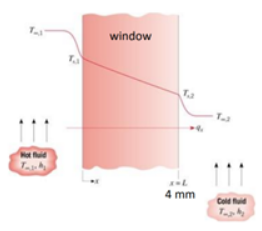The 4-mm-thick rear window of an automobile is defogged by passing warm air over its inner surface. Warm air temperature is at T,1 = 40C and corresponding convection coefficient is h1 =30 W/(m2·K). Outer ambient temperature T,2 = 5C and corresponding convection coefficient is h2 = 70 W/(m2·K). The size of the window is 0.5 m (height) 1.5 m (width). A. Draw two thermal circuits (one based on heat rate and one based on heat flux) considering the convection occurring over inner and outer surfaces and the conduction through the window. Show the equations for the thermal resistances in the circuits. B. Determine the total thermal resistance based on heat flux in m2K/W and overall heat transfer coefficient U in W/m2K. Find the thermal conductivity of glass (soda lime at 300K) C. Determine the inner and outer temperatures of the glass (that are Ts,1 and Ts,2 shown above).
The 4-mm-thick rear window of an automobile is defogged by passing warm air over its inner surface. Warm air temperature is at T,1 = 40C and corresponding convection coefficient is h1 =30 W/(m2·K). Outer ambient temperature T,2 = 5C and corresponding convection coefficient is h2 = 70 W/(m2·K). The size of the window is 0.5 m (height) 1.5 m (width).
A. Draw two thermal circuits (one based on heat rate and one based on heat flux) considering the convection occurring over inner and outer surfaces and the conduction through the window. Show the equations for the thermal resistances in the circuits.
B. Determine the total thermal resistance based on heat flux in m2K/W and
overall heat transfer coefficient U in W/m2K. Find the thermal conductivity of glass (soda
lime at 300K)
C. Determine the inner and outer temperatures of the glass (that are Ts,1 and Ts,2 shown above).

Given:

To find:
Thermal circuit
Thermal resistance
Inner and outer temperature
Trending now
This is a popular solution!
Step by step
Solved in 4 steps with 3 images









